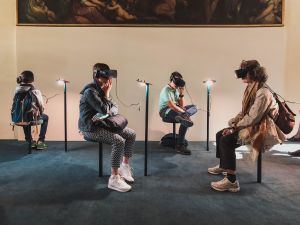Test Owner
2022 trends in the IT industry
It is expected that the trends that have developed within the IT industry in recent years will continue throughout the next decade. These trends include a particular focus on developing artificial intelligence and automation, in order to keep up with the demands of a rapidly modernising world. The impact of the COVID-19 pandemic can also be seen here, as faster technology is needed to cope with the demand of working remotely.
Automation, according to codequotient.com, will be one of the main drivers of developments within the IT industry. Automation is often needed in daily life, from banks to supermarkets and large businesses to small ones; improving it is thus a top priority for many. Cloud computing (and, importantly, ensuring the security of this cloud) will also continue to be a focus of the industry, as this is a large source of revenue. The stratospheric popularity of cryptocurrency will also make this an area of interest for IT specialists, as public interest in new forms of currency continues to grow. A fourth area of interest within the industry will be making technology more accessible to greater numbers of people, thereby increasing its user base and possible future interest.
2022 will be a year of continued growth and development in the industry, working to meet the needs of a changing society. These trends should be expected to continue past this year, as the demand for fast and reliable technology and storage continues to grow.
Source www.codequotient.com
Amazon Web Services, along with many other tech companies, have released their predictions for the areas of technology that they believe will prove most lucrative over the next few years. AWS currently hosts a significant portion of the internet’s cloud storage, having pioneered cloud technology for well over a decade.
AWS Vice President Werner Vogels expressed his excitement for the continuing development of technology that “augment[s] how we engage with the world”; this includes artificial intelligence and cloud storage. The five areas that AWS expects to be crucial this year are AI, cloud storage, smart spaces, sustainability, and connectivity.
AWS expects that AI will start to be used in software development, to aid and speed up the process by helping developers to create secure and reliable codes. This will be particularly useful when it comes to spotting scams and fraudulent content online, potentially protecting many internet users from exploitation. The cloud will also be a key area of development as it will aid the development of specialised technology in daily life, connecting to almost every digital device on the planet. Smart spaces could provide a solution to the difficulties faced by senior citizens in everyday life, allowing them to turn lights off and lock doors without having to move, and to keep in contact with their families without the risk of physical contact during the pandemic. Sustainability, the fourth area of development highlighted by AWS, is necessary due to the targets set by many governments for emissions reduction; technological advances are crucial to aid us in meeting those targets. The final area of focus is connectivity, trying to bring technology and the internet to everyone so that they can access its benefits. Vogels hopes that underserved communities around the world will benefit from AWS’ commitment to developing connectivity solutions.
Source: www.techhq.com
Trends in ERP software for 2022
Enterprise resource planning software has existed for many years, and is crucial for businesses of all sizes to collect and manage their data. It usually takes the form of a set of related and integrated applications, which together form a unified way of business management.
In 2018, Allied Market Research valued the ERP software market at over $35 billion dollars. The market is mainly dominated by four companies: Oracle, SAP, Sage, and Infor. As a result of the coronavirus pandemic, the demand for reliable supply chains across the world has increased: this demand can be met by ERP software, and so its market value is predicted to increase massively in the years to come.
The ERP software market is able to enjoy such success through continual innovation; developers are always coming up with new ways to expediate the process of business management. This innovation, of course, is targeted at the demands of consumers. According to Market Watch, consumers are now looking for increased transparency and efficiency within business processes and help with data-driven decision-making, among other things. There has also been a notable uptick in demand from smaller businesses aiming to make their business processes easier and more transparent.
Oracle, which was founded in 1977, is perhaps the most key player within the market, offering cutting edge technology such as machine learning to businesses. The company’s set of applications helps to automate routine tasks, thereby making business processes faster and easier. AI and machine learning also play a key role in the technologies offered by other big ERP companies, such as SAP, Sage, and Infor, and are expected to continue to do so into 2022 and beyond.
Source: www.selecthub.com
What working from home does to your brain
Due to various lockdowns over the last two years, many people have had to work from home or rely on furlough payments for long periods of time. For some, this has allowed them much more freedom and flexibility, and enabled them to spend more time with their families. But for others, the difficulty in separating home life from work life has led to mental health difficulties.
One of the factors contributing to an increase in mental health difficulties is isolation. Naturally, it is much more difficult to feel connected to others when you don’t see them every day, and this can quickly take its toll. Many people have reported feeling insecure and stressed when they don’t have proper human interaction at work, which can then lead to more serious mental health issues. Other features of working from home include greater job insecurity, a loss of control, and an altered sleep schedule, all of which can have a large impact on one’s mental wellbeing.
Certain groups, according to studies undertaken since the beginning of the pandemic, appear to be more vulnerable to mental health difficulties. Women and mothers in particular reported greatly increased levels of stress when beginning to work from home, as well as those with less experience in working in general and those with weaker interpersonal relationships. These groups are particularly affected because they often have other responsibilities to take care of outside work, which naturally creates more stress.
However, these difficulties can be alleviated at home. Making sure that you have time to exercise after work can have a huge positive impact on your mental health, as can following a healthy diet and drinking enough water. Taking a short walk immediately before and after work can mirror the mental impact of a commute, and create a separation between one’s work and home lives. As well as this, arranging to see friends and family according to current coronavirus guidelines can help you to feel much less isolated, and create a support network for you.
Nowadays, while 3D printing in the automotive industry is progressively being adopted, new-age CAD design has acquired more importance, in response to the increasing demand of designers aware of the additive manufacturing design principles.
The founding of the Alias software revolutionized the face of 3D Modeling and Animation as well as the engineering, design, gaming, entertainment, and film industries.
Created by Autodesk, this CAD software applies primarily to surface modelling. It provides tools for sketching, modelling, simulates the effects and reflection of light on surfaces surface design and visualisation for industrial, automobile and product design.
In 2021, Autodesk Alias was split into three distinct products:
- Autodesk Alias AutoStudio (formerly Autodesk Alias Automotive)
- Autodesk Alias Surface (formerly Autodesk Surface Studio)
- Autodesk Alias Concept ( formerly Autodesk Design Studio)
Today, Alias involves a large list of customers including Timex, Reebok. Oakley, Kenner, BMW, GM, Honda, Volvo, Apple, GE, Motorola, Sony, Industrial Light and Magic, Broadway Video and The Moving Picture Company.
As a matter of fact, Johannes Bayer, who is a CA-Styling and Visualization manager at BMW Group Design said: "At BMW, Alias/Wavefront's AutoStudio software is being used for concept design projects, allowing for a maximum amount of flexibility during these processes."
It has been proven that the use of Alias/Wavefront design tools has trully expanded the design and visualization capabilities at BMW since successfully developing the new 3Series coupe with AutoStudio.
It testifies the fact that today, automotive software innovation enables vehicle architecture teams to create unique concept vehicles with confidence that the new designs meet all the required engineering necessities.
Source: www.theautochannel.com
Galvanised French tech sector is becoming a new European investment destination for international investors
Recently, during the 10th edition of France Digital Day, representing more than 1,800 French digital entrepreneurs and investors, the French tech sector announced its ambitious plans to stay atop the tech industry for years to come.
With €8.9bn raised in 2021 YTD (+78% vs 2020), the French Tech VC ecosystem has matured, and Bristol-based Tech focussed investment bank ICON Corporate Finance predicts France will play a major role in creating European Tech champions such as Sorare, Alan, Ledger, Mirakl, Back Market, amongst others.
Indeed, Sorare, declared they had earned $555 million - a record for French tech - by creating a digital card exchange game based on blockchain, whereas Mirakl, an online marketplace specialist had raised $473 million.
Today, the number of French Unicorns, defined as unlisted start-ups valued at least one billion Euros, doubled to 21 in 2021 YTD.
As a matter of fact, Minister Bruno le Maire told during a conference “We were a start-up nation; we are going to become a nation of large technology companies”. Indeed, the government indicated that by 2025 it aimed to have 25 “unicorns”.
Alan Bristow, CEO of ICON, commented that “Funding to European tech companies has reached record-breaking levels” making France now lies third in European tech rankings, behind the UK and Germany, boosted by government investment of $4bn, Brexit, and post-pandemic optimism among investors.
Source: www.euractiv.com
Gekko part of Accenture
En juin 2020, Accenture complétait son acquisition de Gekko, entreprise française leader des services Amazon Web Services (AWS),dans la continuité de sa stratégie « Cloud First »
Gekko compte plus d’une centaine de professionnels formés aux technologies du cloud, de 100 certifications AWS et d’une relation forte avec AWS.
Accenture, avec ses 509 000 employés dans plus de 120 pays, est un des leaders mondiaux des services aux entreprises et administrations et s’appuie sur le plus grand réseau international de centres de technologie avancée et d’opérations intelligentes.
Cette acquisition a permis de renforcer la position de leader d’Accenture dans le domaine du Cloud et de l’IA, d’élargir la collaboration existante avec les fournisseurs clés du marché, au premier rang desquels l’écosystème de partenaires Amazon, Google et Microsoft et renforcer les services de migration vers le cloud pour soutenir les objectifs stratégiques d’Accenture AWS Business Group (AABG) en France, Belgique, Luxembourg et aux Pays-Bas.
Constamment à la recherche de nouveaux talents pour les rejoindre Gekko part of Accenture se concentre sur 4 domaines d'expertise : - Cloud Adoption : Design & architecture, migration, change management, hybridation / DirectConnect, formation. - Industrialisation DevOps : Infra-as-code / Patterns, Chaîne CI/CD,Forge, Build to Run. - CloudOps & FinOps : Run “Next Gen” (exploitation full automatisée), gouvernance financière et opérationnelle du Cloud, optimisation financière.
Source: Gekko – Part of Accenture https://newsroom.accenture.fr
Today, the company Framatome announced the completion of its purchase of Rolls Royce Civil Nuclear Instrumentation and Control (I&C). The deal which was first announced back in December 2020, will enlarges the industrial footprint of Framatome, and expands its global I&C systems development and deployment capabilities.
Framatome is an international leader in nuclear energy: the company is renowned for its reliability, its expertise and its performance in designs and installation of components, fuel, and instrumentation and control systems for nuclear power plants.
Rolls-Royce says the deal, for which it provides no financial details, contributes to the target it set last year of GBP2 billion in disposals. The I&C business had GBP74 million in revenue in 2020.
Through this transaction, more than 550 employees mainly located in France will be a part of the company. At the same time, Rolls-Royce Civil Nuclear’s products and technologies such as Spinline, Rodline and Hardline will be incorporated into Framatome’s I&C portfolio.
However, none of the group's employees based in the United Kingdom will be impacted by this transaction. Indeed, it does not include the civil nuclear activities of Rolls-Royce in the United Kingdom, nor those concerning the small modular reactors (SMR- Small Modular Reactor) which will still contribute to locally supplying low-carbon electricity.
Additionally, this purchase will allow new resources to the I&C in order to offer more reliable, low carbon nuclear energy production which is becoming a real issue nowadays.
Source: https://www.framatome.com
Almost every industry across the globe is still struggling to recover from the coronavirus pandemic’s effect on 2020 sales and the MedTech sector was not spread at all: indeed, the impact was far from even, given the diverse range of MedTech companies, from those that make heart valves to artificial hips and knees to robotics to point of care testing.
Despite these difficulties, The Midwest’s Largest Annual Design and Manufacturing Event took place last week between the 2 and 3 November. It included the latest insights and solutions spanning medtech, packaging, automation, plastics, and design.
OmniVision Technologies Inc. demonstrated its OVMed OH0FA image sensor and OAH0428 bridge chip for endoscopes and catheters during MD&M Minneapolis. The company states this new image sensor presents the highest available resolution for ENT, cardiac, arthro, OB-GYN, and utero-renal endoscopes. The OAH0428 bridge chip, compatible with 720x720 resolution, offers analog-to-digital conversion and flexibility for a variety of analog and digital inputs and outputs.
Ehsan Ayar, the medical product marketing manager at OmniVision, stated in a news release “ We have designed the OH0FA image sensor to offer the highest resolution at the best frame rate possible, with the flexibility to increase the frame rate at a lower resolution to cater to procedures with different requirements. Additionally, we have built in a high level of flexibility with the OAH0428 bridge chip.”
An other product presented during this event was “FlexSense” which is a wireless sensor technology. The company described this device as stretchable, compressible, and wearable, suiting it for applications in athletics, health, and wellness. They are made of a silicon-based material and conductive ink that can withstand use environments including heat, cold, and moisture.
Additionally, a new medical 3D printer the Core 5 Series Med XL – 385 created by B9Creations was shown during the event: The system is suitable for the design and production of medical devices, anatomical modelling, surgical tools, and more. Its particularity remains in the fact the company succeeded in realising a translucent companion resin called HD Clear. According to the company, the printed parts can be made fully transparent and appear glass-like.
Innovation today is the only solution for MedTech’s to navigate the sales environment through the pandemic.
This week, Facebook indicated its decision to foster 10,000 new jobs in the EU committed into building the Metaverse, which has became one of its big priorities.
But what is Metaverse?
Metaverse is defined by being " a virtual-reality space in which users can interact with a computer-generated environment and other users”
That means that unlike current VR, which is mostly limited to gaming, this virtual world would allow you to connect with all sorts of digital environments such as work, play, concerts, cinema trips - or just hanging out.
Even if its definition is still pretty indefinite, the incorporation of an avatar - a representation of yourself - as you use it is probably one of its main components.
An unexpectedly value?
Metaverse is suddenly becoming a main concern for investors and big tech firms, who don’t want to miss this promising opportunity, which might become “the future of the internet.”
With the constant advancements in VR gaming, the interests are rising as testify the involvement of Facebook
Indeed, while they were improving their Oculus headsets, making them more competitive on the market, they also kept developing VR apps for social hangouts and for the workplace, which will include connections with reality.
However, Facebook emphasised the fact it has the desire to collaborate; being aware than “the Metaverse "won't be built overnight by a single company". Consequently the firm has invested “ $50m (£36.3m) in funding non-profit groups to help build the Metaverse responsibly.
Nethertheless, as Facebook already know it, the Metaverse idea is still in an early stage, targeted by multiple tech giants, which will take another 10 to 15 years to come to an end.
Source: www.bbc.co.uk














